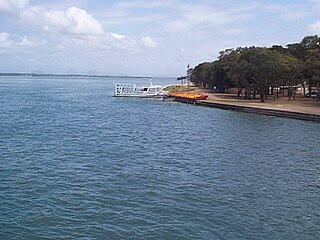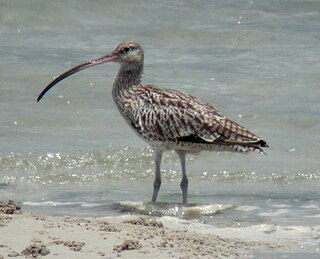
Broome, also known as Rubibi by the Yawuru people, is a coastal, pearling and tourist town in the Kimberley region of Western Australia, 1,681 km (1,045 mi) north of Perth. The estimated urban population was 13,984 in August 2016. It is the largest town in the Kimberley region.

Birdwatching, or birding, is the observing of birds, either as a recreational activity or as a form of citizen science. A birdwatcher may observe by using their naked eye, by using a visual enhancement device like binoculars or a telescope, by listening for bird sounds, or by watching public webcams.

The Royal Australasian Ornithologists Union (RAOU), now part of BirdLife Australia, was Australia's largest non-government, non-profit, bird conservation organisation. It was founded in 1901 to promote the study and conservation of the native bird species of Australia and adjacent regions, making it Australia's oldest national birding association. In 1996, the organisation adopted the trading name of Birds Australia for most public purposes, while retaining its original name for legal purposes and as the publisher of its journal, the Emu. In 2012, the RAOU merged with Bird Observation & Conservation Australia to form BirdLife Australia.

Roebuck Bay is a bay on the coast of the Kimberley region of Western Australia. Its entrance is bounded in the north by the town of Broome, and in the south by Bush Point and Sandy Point. It is named after HMS Roebuck, the ship captained by William Dampier when he explored the coast of north-western Australia in 1699. The Broome Bird Observatory lies on the northern coast of the bay.

Careel Bay is a bay and adjacent locality in Sydney, New South Wales, Australia. The locality is within the suburb of Avalon Beach. The bay lies adjacent to the suburbs of Avalon Beach and Palm Beach in the north east of Pittwater.

Eighty Mile Beach, also spelled Eighty-mile Beach or 80-mile Beach, lies along the north-west coast of Western Australia about half-way between the towns of Broome and Port Hedland. It is a beach some 220 kilometres (140 mi) in length, forming the coastline where the Great Sandy Desert approaches the Indian Ocean. It is one of the most important sites for migratory shorebirds, or waders, in Australia, and is recognised as a wetland of international importance under the Ramsar Convention on Wetlands.

Wingspan was the quarterly membership magazine of the Royal Australasian Ornithologists Union (RAOU). It was first issued in 1991, replacing the RAOU Newsletter. When Birds Australia and Bird Observation and Conservation Australia merged in 2012 to form BirdLife Australia, Wingspan's run ended, and was replaced with Australian Birdlife magazine.
The Australasian Wader Studies Group (AWSG), established in 1981, is a special interest group of BirdLife Australia. It publishes a journal, The Stilt, usually twice a year, with occasional extra issues. Its mission statement is "to ensure the future of waders (shorebirds) and their habitats in Australia through research and conservation programs and to encourage and assist similar programmes in the rest of the East Asian - Australasian Flyway".
Clive Dudley Thomas Minton, AM was a British and Australian metallurgist, administrator, management consultant and amateur ornithologist. His interest in birds began in childhood.

The East Asian–Australasian Flyway is one of the world's great flyways. At its northernmost it stretches eastwards from the Taimyr Peninsula in Russia to Alaska. Its southern end encompasses Australia and New Zealand. Between these extremes the Flyway covers much of eastern Asia, including China, Japan, Korea, South-East Asia and the western Pacific. The EAAF is home to over 50 million migratory water birds from over 250 different populations, including 32 globally threatened species and 19 near threatened species. It is especially important for the millions of migratory waders or shorebirds that breed in northern Asia and Alaska and spend the non-breeding season in South-East Asia and Australasia.

The Miranda Naturalists' Trust is a charitable trust, that established and maintains the Miranda Shorebird Centre, located at Pūkorokoro / Miranda on the western shore of the Firth of Thames on the North Island of New Zealand. The Miranda Naturalists' Trust (MNT) was formed in 1975 to encourage people to visit the coastline and appreciate its wide range of flora and fauna. The trust promotes education and public awareness of coastal ecology, shorebird research and conservation. Work done by the trust, to increase knowledge of shorebird migration, includes bird banding, research and data exchange. The Shorebird Centre has information displays on waders and a library and helps raise funds for the trust's work through their shop sales and visitor accommodation.

The Dampier Peninsula is a peninsula located north of Broome and Roebuck Bay in Western Australia. It is surrounded by the Indian Ocean to the west and north, and King Sound to the east. It is named after the mariner and explorer William Dampier who visited it. The northernmost part of the peninsula is Cape Leveque. It is sparsely inhabited, mostly by Indigenous Australian peoples, some of whom have been granted native title rights to some of their traditional lands. There are many coastal inlets, bays and other features, including Beagle Bay on its western side.

Pumicestone Channel, also known as the Pumicestone Passage, is a narrow waterway between Bribie Island and the mainland in Queensland, Australia. The northern extent of the passage is at Caloundra, while at the south is Deception Bay. The waterway is a two way tidal estuary that has 11 creeks flowing into it. At each end of the passage the channels are the deepest and widest.
The Victorian Wader Study Group (VWSG) is an Australian non-profit, volunteer, ornithological fieldwork group that gathers biometric and other data on waders and terns, mainly through regular catches of large samples of several species by cannon-netting at sites along the coast of Victoria.
The Yawuru, also spelt Jawuru, are an Indigenous Australian people of the Kimberley region of Western Australia.

Buckingham Bay is a large, rectangular bay on the northern coast of Arnhem Land, in the Northern Territory of Australia. It lies 520 km east of Darwin and 120 km west of Nhulunbuy.

BirdLife Australia is a not-for-profit organisation advocating for native birds and the conservation of their habitats across Australia.

The Cadell and Blyth Floodplains consist of the 432 square kilometres (167 sq mi) floodplain of the lower reaches of the Blyth and Cadell Rivers of northern Arnhem Land in the Top End of the Northern Territory of Australia. It is an important site for waterbirds.

Theunis Piersma is a Dutch ornithologist, ecologist, and educator. He is among the most influential ornithologists, particularly in the wader bird area, in the world. He specifically looks at waders and correlations between flock size and distribution, climate, food, predators, pathogens, and their historical-genetic background. RTV Drenthe referred to him in 2012 as the "first migratory bird professor in the world."
Roebuck Plains Station is a pastoral lease that is located close to the township of Broome in the Kimberley region of Western Australia. It is one of the closest pastoral leases to Broome.















